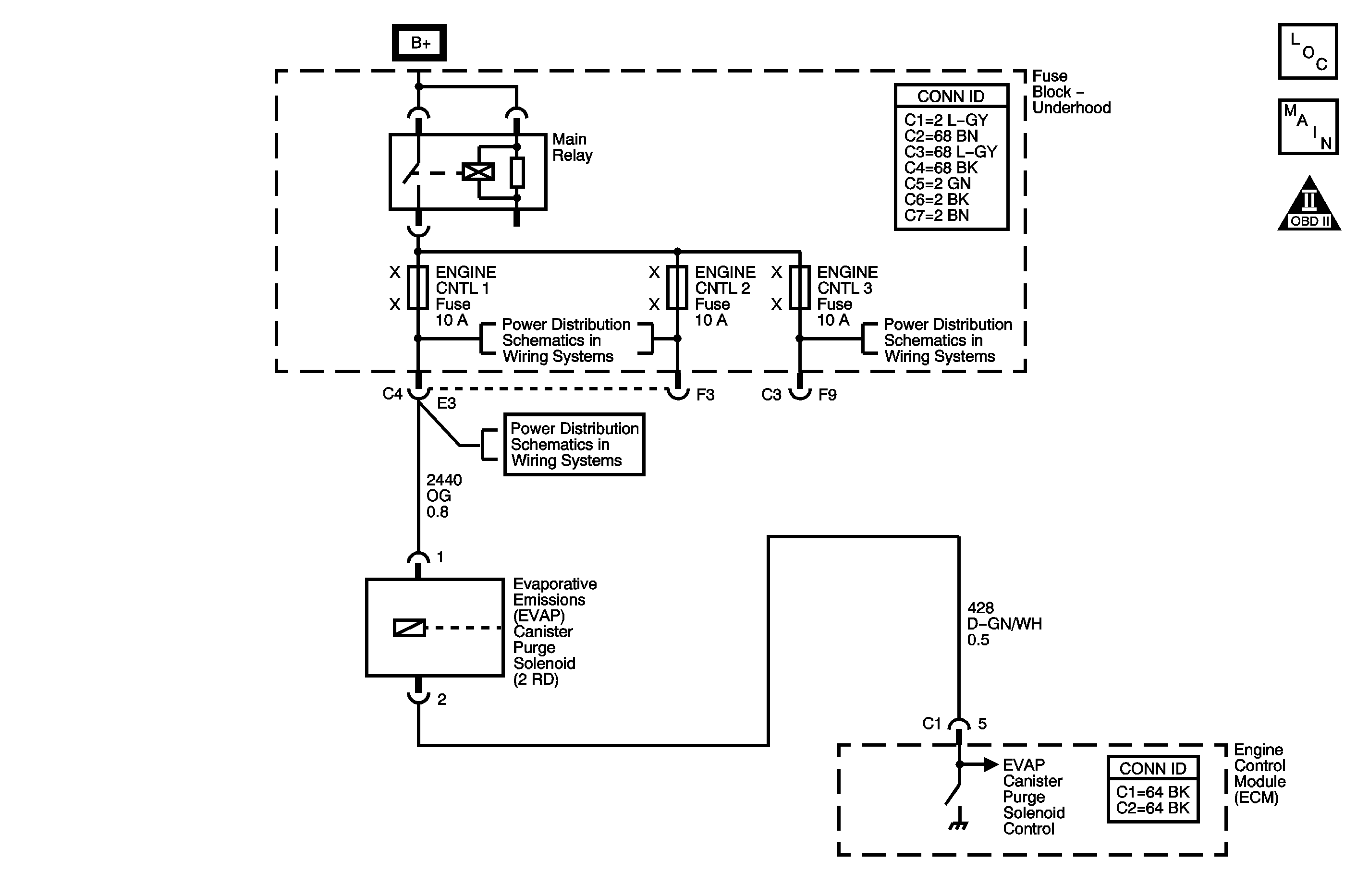
System Description
This DTC tests for undesired intake manifold vacuum flow to the evaporative emission (EVAP) system. The control module seals the EVAP system by commanding the EVAP canister purge solenoid valve OFF and the EVAP canister vent solenoid valve ON. The control module monitors the fuel tank pressure (FTP) sensor to determine if a vacuum is being drawn on the EVAP system. If vacuum in the EVAP system is more than a predetermined value within a predetermined time, this DTC sets.
The following table illustrates the relationship between the ON and OFF states, and the Open or Closed states of the EVAP canister purge and vent solenoid valves.
Control Module Command | EVAP Canister Purge Solenoid Valve | EVAP Canister Vent Solenoid Valve |
|---|---|---|
ON | Open | Closed |
OFF | Closed | Open |
DTC Descriptor
This diagnostic procedure supports the following DTC:
DTC P0496 EVAP System Flow During Non-Purge
Conditions for Running the DTC
| • | DTCs P0030, P0031, P0032, P0036, P0037, P0038, P0050, P0051, P0052, P0056, P0057, P0058, P0117, P0118, P0121, P0122, P0123, P0125, P0128, P0131, P0132, P0133, P0134, P0135, P0136, P0137, P0138, P0139, P0140, P0141, P0150, P0151, P0152, P0153, P0154, P0155, P0156, P0157, P0158, P0159, P0160, P0161, P0221, P0222, P0223, P0442, P0443, P0446, P0449, P0451, P0452, P0453, P0455, P0458, P0459, P0498, P0499, P0506, P0507, P1271, P1277, P1278, P1282, P1283, P1511, P1516, P1519, P1523, P1526, P1530, P1551, P2100, P2101, P2107, P2119, P2122, P2123, P2127, P2128, P2138, P2176 are not set. |
| • | The EVAP canister purge solenoid valve is commanded OFF. |
| • | The EVAP canister vent solenoid valve is commanded ON. |
| • | The engine is at idle. |
| • | The vehicle speed is 0 km/h (0 mph). |
| • | The engine load is less than 35 percent. |
| • | The manifold absolute pressure (MAP) is less than 40 kPa. |
| • | The battery voltage is between 10.5-17.3 volts. |
| • | The engine coolant temperature (ECT) at engine start-up is between 8-75°C (46-167°F). |
| • | The intake air temperature (IAT) is between 8-75°C (46-167°F). |
| • | The long term fuel trim (FT) cells are learned. If not learned, the engine must run longer than 16 minutes and 45 seconds. |
| • | The fuel level is between 6-48 liters (1.6-12.7 gallons). |
| • | DTC P0496 diagnostic runs once per ignition cycle. |
Conditions for Setting the DTC
The control module detects vacuum during a non-purge condition.
Action Taken When the DTC Sets
| • | The control module illuminates the malfunction indicator lamp (MIL) on the second consecutive ignition cycle that the diagnostic runs and fails. |
| • | The control module records the operating conditions at the time the diagnostic fails. The first time the diagnostic fails, the control module stores this information in the Failure Records. If the diagnostic reports a failure on the second consecutive ignition cycle, the control module records the operating conditions at the time of the failure. The control module writes the operating conditions to the Freeze Frame and updates the Failure Records. |
Conditions for Clearing the DTC
| • | A current DTC Last Test Failed clears when the diagnostic runs and passes. |
| • | A history DTC clears after 40 consecutive warm-up cycles, if no failures are reported by this or any other non-emission related diagnostic. |
| • | Clear the DTC with a scan tool. |
Diagnostic Aids
| • | If DTCs P0442, P0445, or P0446 are set, EVAP special functions on the scan tool will not be allowed. Clear DTCs before performing these tests. |
| • | The engine control module (ECM) uses the FTP sensor to detect the vapor in the fuel tank during all parts of the EVAP diagnostic system test. Ensure the FTP sensor is not skewed by verifying FTP sensor on the scan tool is between 2.35-2.85 volts with the ignition ON and the engine OFF. |
| • | The most likely cause of DTC P0496 is a stuck open EVAP purge solenoid valve. Command the EVAP purge solenoid valve ON at 70 percent duty cycle with the scan tool. The valve should click at an even rate. |
| • | For intermittent conditions, refer to Intermittent Conditions . |
Step | Action | Values | Yes | No |
|---|---|---|---|---|
Schematic Reference: Evaporative Emissions Hose Routing Diagram | ||||
1 | Did you perform the Diagnostic System Check - Vehicle? | -- | Go to Step 2 | Go to Diagnostic System Check - Vehicle in Vehicle DTC Information |
2 |
Is the FTP parameter within the specified range? | -1 to +1 in H2O | Go to Step 3 | Go to DTC P0451 |
3 |
Does the gage indicate an increase in vacuum? | 1,200-1,500 RPM | Go to Step 4 | Go to Diagnostic Aids |
4 | Replace the EVAP canister purge solenoid valve. Refer to Evaporative Emission Canister Purge Solenoid Valve Replacement . Did you complete the replacement? | -- | Go to Step 5 | -- |
5 |
Is the FTP parameter within the specified value? | -1 to +1 in H2O | Go to Step 6 | Go to Step 2 |
6 | Observe the Capture Info with a scan tool. Are there any DTCs that have not been diagnosed? | -- | Go to Diagnostic Trouble Code (DTC) List - Vehicle in Vehicle DTC Information | System OK |
